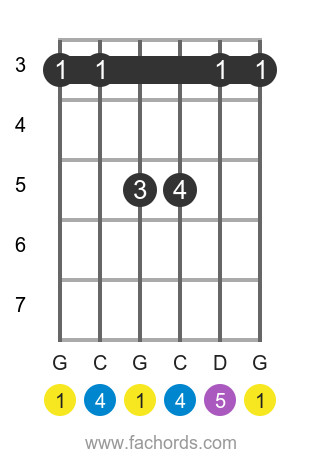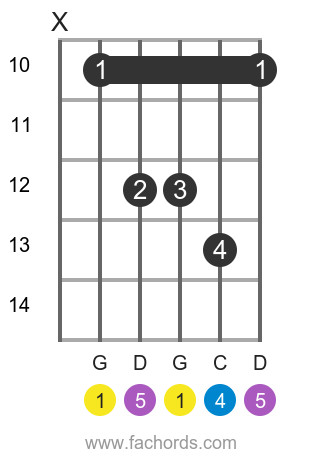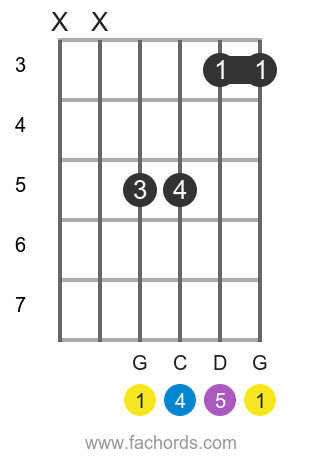Welcome to your comprehensive guide on the Gsus4 chord, a captivating and frequently used chord in guitar music. As part of the suspended chords family, the Gsus4 brings a unique flavor to your playing, offering a richer and more nuanced sound compared to basic major or minor chords. This chord, constructed from the notes G, C, and D, utilizes the 1st, 4th, and 5th intervals of the G major scale – also known as the Root, Perfect Fourth, and Perfect Fifth.
If you’re interested in deepening your understanding of chord construction and music theory, exploring resources on guitar music theory and fretboard intervals can be incredibly beneficial. These tutorials can illuminate how intervals are stacked to create the chords you play. For a broader perspective on suspended chords and their application, our dedicated tutorial on suspended guitar chords offers valuable insights. Furthermore, expanding your overall chord vocabulary is essential for any guitarist, and our full tutorial on guitar chords of all types is a fantastic resource for this.
This guide will specifically focus on mastering the Gsus4 chord. We’ll provide clear chord diagrams and fretboard patterns, visually highlighting the notes that compose this chord. Ready to add the intriguing sound of the Gsus4 to your guitar repertoire? Let’s dive in!
Decoding the Gsus4 Chord: Notes and Formula
The Gsus4 chord is built from three fundamental notes:
- G – the Root (1st interval)
- C – the Perfect Fourth (4th interval)
- D – the Perfect Fifth (5th interval)
These intervals are derived from the G major scale. Instead of the major third found in a G major chord, the Gsus4 substitutes it with the perfect fourth (C), creating its characteristic “suspended” sound.
The chord formula for a sus4 chord, applicable to Gsus4 and all other sus4 chords, is represented numerically as:
1 – 4 – 5
This formula signifies the root, the perfect fourth, and the perfect fifth intervals relative to the root note, which in this case is G.
Exploring the Gsus4 Chord on the Fretboard
To visualize and play the Gsus4 chord effectively, interactive fretboard tools are incredibly helpful. These tools show you the placement of the Gsus4 chord across the entire guitar neck, enabling you to understand its versatility beyond a single position.
Chord diagrams are presented in order of difficulty, starting with the easiest shapes. If you are new to reading these diagrams, our tutorial on how to read chord diagrams will provide the necessary guidance. For guitarists who find barre chords challenging, our Bar Chords Tips tutorial offers valuable techniques and exercises to improve barre chord execution.
For a text-based alternative to chord diagrams, you can also explore our accessible chords page, which provides written instructions for playing the Gsus4.
Gsus4 Chord Positions: From Open to Barre Chords
The Gsus4 chord can be played in various positions on the guitar neck, offering different voicings and ease of play. Here are some common positions:
Position 1: Open Position
 Gsus4 chord open position diagram for guitar, showing fingering on the fretboard
Gsus4 chord open position diagram for guitar, showing fingering on the fretboard
The open position Gsus4 is often the first shape learned by guitarists. It’s a relatively simple chord to fret and provides a bright, resonant sound.
Position 2: Barre Chord (Movable Shape)
 Gsus4 barre chord position for guitar, diagram illustrating how to play it
Gsus4 barre chord position for guitar, diagram illustrating how to play it
This barre chord shape is movable, meaning you can slide it up and down the neck to play different sus4 chords. Mastering barre chords expands your ability to play chords across the fretboard.
Position 3: Barre Chord (Movable Shape)
 Another barre chord shape for Gsus4 on guitar, fretboard diagram showing finger placement
Another barre chord shape for Gsus4 on guitar, fretboard diagram showing finger placement
Another useful barre chord shape for Gsus4, this position offers a different voicing and can be helpful in various musical contexts.
Position 4: Barre Chord (Movable Shape)
 Gsus4 chord barre position diagram for guitar, movable shape on the fretboard
Gsus4 chord barre position diagram for guitar, movable shape on the fretboard
This is yet another movable barre chord shape, providing further options for playing the Gsus4 chord in different parts of the neck.
Explore our extensive all guitar chords library for even more chord shapes and variations. For a handy reference guide, you can also download our Free Guitar Chords Chart Pdf.
Gsus4 and Beyond: Exploring Other Sus4 Chords
Once you’ve become comfortable with the Gsus4, you can easily apply the same sus4 concept to other root notes. Here are some common sus4 chords to explore:
C sus4 | D sus4 | E sus4 | F sus4 | Gsus4 | A sus4 | B sus4 | C#sus4 | D#sus4 | F#sus4 | G#sus4 | A#sus4 | Absus4 | Bbsus4 | Dbsus4 | Ebsus4 | Gbsus4
Experimenting with different sus4 chords will broaden your musical vocabulary and enhance your understanding of chord theory.
Crafting Your Own Gsus4 Voicings
The fretboard map below illustrates the notes of the Gsus4 chord across the guitar neck. By understanding these note positions, you can create your own unique fingerings and voicings for the Gsus4 chord in any area of the fretboard. Some shapes will sound richer and more resonant than others, so trust your ear and experiment to find what sounds best to you in different musical situations.
[Fretboard map – original fretboard map content would be placed here if it was provided in text format]
In Conclusion
The Gsus4 chord is a valuable addition to any guitarist’s toolkit. Its suspended sound adds depth and interest to chord progressions and melodies. By learning the different positions and understanding its construction, you can effectively incorporate the Gsus4 chord into your playing and songwriting. Keep practicing these shapes and exploring how the Gsus4 chord can enhance your musical expression.
